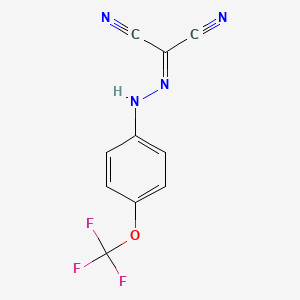Compound
D0181 | FCCP
| Toxicity | Dose | Time | Species | Model | Method | Action | Positive criterion | Reference |
|---|---|---|---|---|---|---|---|---|
| UNCOUPLING | increase | 35 | ||||||
| OXYGEN CONSUMPTION RATE (OCR) | 54±7 nM | 2 minutes | human | HepG2 | Measurement of OCR | increase | EC50 | 7 |
| ECAR | 141±20 nM | 2 minutes | human | HepG2 | Measurement of ECAR | increase | EC50 | 7 |
| GLUCOSE GALACTOSE IC50 RATIO | 2.5 | LUHMES (Lund human mesencephalic) cells | Glc–Gal–NeuriTox assay | Negative | EC25(NA) [Glc/Gal] | 326 | ||
| MITOCHONDRIAL DYNAMICS | 10 μM FCCP for 48 to 72 hours | HeLa cells | 247 | |||||
| Pictogram | Signal | Statements | Precautionary Statement Codes |
|---|---|---|---|
  |
Danger |
Aggregated GHS information provided by 194 companies from 3 notifications to the ECHA C&L Inventory. Each notification may be associated with multiple companies. H301 (100%): Toxic if swallowed [Danger Acute toxicity, oral] H317 (98.97%): May cause an allergic skin reaction [Warning Sensitization, Skin] H413 (98.97%): May cause long lasting harmful effects to aquatic life [Hazardous to the aquatic environment, long-term hazard] Information may vary between notifications depending on impurities, additives, and other factors. The percentage value in parenthesis indicates the notified classification ratio from companies that provide hazard codes. Only hazard codes with percentage values above 10% are shown. |
P261, P264, P270, P272, P273, P280, P301+P310, P302+P352, P321, P330, P333+P313, P363, P405, and P501; (The corresponding statement to each P-code can be found at the GHS Classification page.) |
| Organism | Test type | Route | Dose (normalized dose) | Effect | Source |
|---|---|---|---|---|---|
| mouse | LD50 | intraperitoneal | 8mg/kg (8mg/kg) | Biochemical Pharmacology. Vol. 18, Pg. 1389, 1969. | |
| ((4-(Trifluoromethoxy)phenyl)hydrazono)malononitrile | (4-(Trifluoromethoxy)phenyl)hydrazonopropanedinitrile | (4-(trifluoromethoxy)phenyl)carbonohydrazonoyl dicyanide |
| ({[4-(trifluoromethoxy)phenyl]amino}azamethylene)methane-1,1-dicarbonitrile | 1-cyano-N-[4-(trifluoromethoxy)phenyl]methanecarbohydrazonoyl cyanide | 2-(2-[4-(TRIFLUOROMETHOXY)PHENYL]HYDRAZONO)MALONONITRILE |
| 2-([4-(Trifluoromethoxy)phenyl]hydrazono)malononitrile # | 2-[2-[4-(Trifluoromethoxy)phenyl]hydrazono]malononitrile | 2-[[4-(trifluoromethoxy)phenyl]hydrazinylidene]propanedinitrile |
| 2-{2-[4-(Trifluoromethoxy)phenyl]hydrazono}malononitrile | 370-86-5 | ACM370865 |
| AK546688 | AKOS004121079 | B5004 |
| BCP29558 | BMZRVOVNUMQTIN-UHFFFAOYSA-N | BRD-K14821540-001-02-1 |
| BRD-K14821540-001-03-9 | BRN 4693268 | BS0078 |
| BSPBio_001069 | Bio1_000432 | Bio1_000921 |
| Bio1_001410 | Bio2_000365 | Bio2_000845 |
| C-15732 | C10H5F3N4O | C3463 |
| CARBONYL CYANIDE p-TRIFLUOROMETHOXYPHENYL HYDRAZONE | CCG-56026 | CHEBI:75458 |
| CHEMBL457504 | CS-5732 | CTK7C4861 |
| Carbonyl Cyanide para Trifluoromethoxyphe | Carbonyl cyanide 4-(trifluoromethoxy)phenylhydrazon;Carbonyl cyanide-p-trifluoromethoxyphenylhydrazone | Carbonyl cyanide 4-(trifluoromethoxy)phenylhydrazone |
| Carbonyl cyanide 4-(trifluoromethoxy)phenylhydrazone, >=98% (TLC), powder | Carbonyl cyanide 4-trifluoromethoxyphenylhydrazone | Carbonyl cyanide p-(trifluoromethoxy)phenylhydrazone |
| Carbonyl cyanide p-trifluoromethoxyphenylhydrazone | Carbonyl cyanide, 4-(trifluoromethoxy)phenylhydrazone | Carbonyl cyanide, 4-trifluoromethoxyphenylhydrazone |
| Carbonyl cyanide-4-(trifluoromethoxy)phenylhydrazone | Cyto10H8 | DTXSID40190494 |
| EINECS 206-730-8 | EX-A2029 | F9995-2716 |
| FCCP | FT-0610900 | HMS1362E11 |
| HMS1792E11 | HMS1990E11 | HMS3266A16 |
| HMS3403E11 | HMS563F15 | HY-100410 |
| IDI1_002120 | KBio2_000409 | KBio2_002977 |
| KBio2_005545 | KBio3_000777 | KBio3_000778 |
| KBioGR_000409 | KBioSS_000409 | LS-52242 |
| MCULE-4712161118 | Maybridge1_007693 | Mesoxalonitrile, (p-(trifluoromethoxy)phenyl)hydrazone |
| Mesoxalonitrile, (p-(trifluoromethoxy)phenyl)hydrazone (8CI) | N-(4-(trifluoromethoxy)phenyl)carbonohydrazonoyl dicyanide | NCGC00092274-01 |
| NCGC00092274-02 | NCGC00092274-03 | NCGC00092274-04 |
| PC0578 | PS-10973 | Propanedinitrile, ((4-(trifluoromethoxy)phenyl)hydrazono)- |
| Propanedinitrile, ((4-(trifluoromethoxy)phenyl)hydrazono)- (9CI) | Propanedinitrile, [[4-(trifluoromethoxy)phenyl]hydrazono]- | Q1649579 |
| QTL1_000036 | SBB101377 | SCHEMBL345231 |
| SR-01000645014-1 | SR-01000645014-2 | ZINC110861 |
| ZX-AP008931 | [4-(Trifluoromethoxy)phenyl]carbonohydrazonoyl Dicyanide | [4-(Trifluoromethoxy)phenylhydrazono]malononitrile |
| s8276 | trifluoromethoxy carbonylcyanide phenylhydrazone | {[4-(Trifluoromethoxy)phenyl]-hydrazono}malononitrile |
| {[4-(trifluoromethoxy)phenyl]hydrazono}malononitrile |
| CAS Number | 370-86-5 |
| PubChem Compound | 3330 |
| ChEBI | 75458 |
| ChemSpider | 3213 |
| Wikipedia | Carbonyl cyanide-p-trifluoromethoxyphenylhydrazone |
1. Meyer et al. (2017)
2. Pletjushkina et al. (2006)

